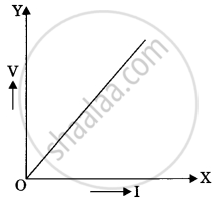Advertisements
Advertisements
Question
Define temperature coefficient of resistance.
Solution
The temperature coefficient is defined as the ratio of the increase in resistivity per degree rise in temperature to its resistivity at T0.
APPEARS IN
RELATED QUESTIONS
If the potential difference across the ends of a conductor is 220 V and the resistance of the conductor is 44 Ω (ohm), then the current flowing through is _________.
- 0.2 A
- 0.5 A
- 2 A
- 5 A
Find the resistance of a conductor if 0.24 A current is passing through it and a potential difference of 24 V is applied across it.
Name the unit of electrical resistance and give its symbol.
The unit of electrical resistance is:
(a) ampere
(b) volt
(c) coulomb
(d) ohm
The graph between V and I for a conductor is a straight line passing through the origin.
What should remain constant in a statement of this law?
What are non-ohmic conductors? Give one exmaple. Draw a current-voltage graph for a non-ohmic conductor.
Explain the equivalent resistance of a series resistor network.
The slope of voltage (V) versus current (I) is called:

A metal rod of length 10 cm and a rectangular cross-section of 1 cm × `1/2` cm is connected to a battery across opposite faces. The resistance will be ______.
You are provided with a resistor, a key, an ammeter, a voltmeter, four cells of 1.5 V each and few connecting wires. Using circuit components, draw a labelled circuit diagram to show the setup to study Ohm's law.
State the relationship between potential difference (V) across the resistor and the current (I) flowing through it. Also draw V-I graph, taking V on the X-axis.
